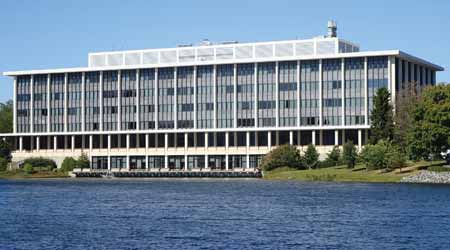 An advanced microgrid is being developed at the Public Safety Headquarters facility in Montgomery County, Md. The initiative will improve resilience, reduce greenhouse gas emissions, and help control energy costs. Schneider Electric
An advanced microgrid is being developed at the Public Safety Headquarters facility in Montgomery County, Md. The initiative will improve resilience, reduce greenhouse gas emissions, and help control energy costs. Schneider ElectricPEER: A New Rating System For Power System Performance
Modeled after LEED, the Performance Excellence in Electricity Renewal (PEER) rating system, recognizes leaders for improving efficiency and works for all project types,
OTHER PARTS OF THIS ARTICLEPt. 1: This Page
Modernizing today’s power systems plays an important role in advancing sustainability goals, while also improving overall resilience and reliability. Around the world, power outages drastically reduce economic productivity and, according to the Department of Energy, cost at least $150 billion each year.
Advancing clean, efficient and reliable energy, PEER is the world’s first certification program that measures and improves power system performance and electricity infrastructure. Modeled after LEED, PEER, or Performance Excellence in Electricity Renewal, recognizes industry leaders for improving efficiency, day-to-day reliability, and overall resiliency in the face of severe events, such as flooding and hurricanes.
The certification program works for all project types, including critical infrastructure, such as hospitals and data centers, as well as corporate campuses, airports, transit systems, private microgrids, distribution centers, and more. Like LEED, PEER was designed to grow with the market and create a global framework for defining high performing and sustainable power systems.
A PEER project includes:
• Two or more buildings.
• A set of power and electricity infrastructure within the boundary/project site.
• In most cases, purchases power electricity and power from at least one other source, such as a utility.
PEER is administered by Green Business Certification Inc. (GBCI), which recently announced four new certifications: NYU Langone Health, one of the top-ranked hospitals in the U.S.; Delhi Metro Rail Corporation (DMRC) in India, the first transit project in the world to achieve certification; Montgomery County Public Safety Headquarters in Maryland; and the City of Glasgow, Ky.
After Superstorm Sandy in 2012, NYU Langone focused on resiliency by implementing its vision of building a more unified campus that includes sustainable architecture, healthy interiors, and energy management as key areas. The hospital has since become a leader in resilient and sustainable design with a new combined heat and power (CHP) plant, emergency generators, and boilers in the building, as well as significant campus perimeter protection and flood prevention measures.
In Maryland, Schneider Electric and Duke Energy Renewables are developing an advanced microgrid that will improve the resilience of the county’s Public Safety Headquarters operations, reduce greenhouse gas emissions, upgrade existing aging electrical infrastructure without capital expenditure, and control energy costs.
Understanding the PEER rating system
PEER applies a straightforward rating system for evaluating outcomes and performance globally. Projects can earn up to 110 points across six credit categories:
• Reliability and resiliency: focuses on monitoring and recording information related to interruptions in service and preventing interruptions or minimizing their effects.
• Energy efficiency and environment: focuses on recognizing and mitigating the inherent costs of energy generation and transmission on the triple bottom line of people, profit. and the planet.
• Operations, management, and safety: focuses on the efficient operations and management of individual systems, while also considering risk for workers and customers.
• Grid services: addresses the implementation of programs and technologies that supplement energy transmission including automation, demand response, and incentives.
• Regional priority: addresses environmental, energy security, safety, social equity, and public health priorities based on geographic location.
• Innovation and exemplary performance: rewards exemplary performance for specific credits.
Currently, there are 20 projects participating in the program. Previous projects that have achieved PEER certification include the City of Chattanooga, Tenn., University of Texas at Austin, and Bucknell University. Additional projects registered and pursuing certification include City of Minster, Ohio, Ft. Knox, Hackensack University Medical Center, Monash University (Australia), Nolin Rural Electric Cooperative Corporation, and Ascendas IT Park Chennai (India).
Related Topics:












